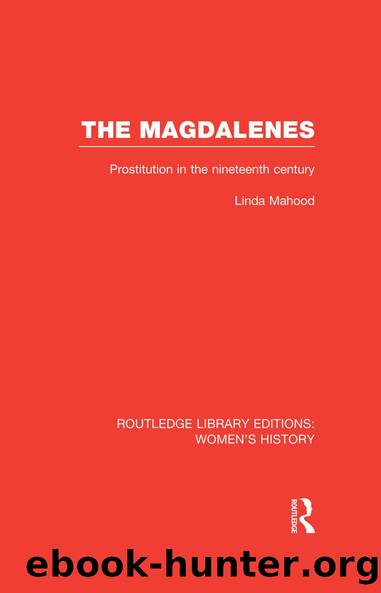The Magdalenes by Linda Mahood

Author:Linda Mahood [Mahood, Linda]
Language: eng
Format: epub
Tags: History, Social History, Modern, 19th Century, Reference, General
ISBN: 9781136247835
Google: uPhtPzZDk6sC
Publisher: Routledge
Published: 2013-06-26T15:56:19+00:00
Chapter six
Friendless, fallen, and inebriate
women: the transformations
By the middle of the nineteenth century the idea of incarcerating women for sexual offences, either through formal channels which landed them in state prisons or through informal channels which led them to magdalene homes, could no longer be considered new. The general philosophy of early magdalene asylums in Scotland and England did not vary significantly from institution to institution, but by the middle of the century the reform strategies they used to achieve these ends began to shift. Critics of rescue work emerged and either developed new institutions and societies or struggled to gain control over older ones. They argued that rescue workers had to do more than merely provide refuges. They incorporated the penitentiary principle within their wider aims as they adopted a more aggressive style and missionary methods. New organizations carried rescue work beyond the provision of refuges for repenting women and career training. They extended their activities to seeking out and saving the 'fallen'.1 Building on chapter four which examined the 'ideas' or discourses of Scottish moral reformers, the purpose of this chapter is to examine their 'activities'. The first section looks at contemporary criticisms of magdalene homes in general. The next section identifies some of the new institutions that opened in Scotland.
The attack on female penitentiaries began in 1840 with the publication of Tait's Magdalenism. Tait had recently become the secretary of the Edinburgh branch of the newly formed Society for the Protection of Young Females and the Prevention of Juvenile Prostitution, which the directors of the Edinburgh Magdalene Asylum regarded as too 'aggressive':
A kindred society has been lately formed in Edinburgh, and it may be thought by some that on that account the Magdalene Asylum will be unnecessary. The directors observe that the object and character of the 2 institutions are quite distinct. The new society . . . is aggressive in its character being designed to prevent the crime of prostitution, by adopting measures for pulling down those haunts of vice to which females are decoyed. The Magdalene Asylum is simply penitentiary in its character, being designed for reception, training and religious instruction.2
Tait attacked the administration of the asylum in Edinburgh for its complacent attitude, for its outdated punitive management practices, and for its location. He claimed that it looked more like a madhouse or prison than a refuge for the penitent, and its location in the centre of the city greatly inhibited its ability to perform its work since it was impossible to institute a full service laundry because the smoke from the surrounding factories contaminated the clothes. Similarly, the privacy of the yard was disturbed by the surrounding dwellings, which meant that the inmates could not work or walk in the yard without being watched by the neighbours. Tait claimed that before anything could be accomplished an asylum had to be located in the country with sufficient space for a laundry and a garden where the inmates would be removed from the temptations of the crowded town and have 'free exercise and employment in the open air'.
Download
This site does not store any files on its server. We only index and link to content provided by other sites. Please contact the content providers to delete copyright contents if any and email us, we'll remove relevant links or contents immediately.
Women and Jewish Marriage Negotiations in Early Modern Italy by Howard Tzvi Adelman(406)
Warrior King by Wilbur Smith(365)
18 real-life stories of serial killers and murderers with solved and unsolved killings from the USA, UK, Europe, and beyond. by Ben Oakley(284)
The Battle of Austerlitz by 50minutes(280)
Violence and Emotions in Early Modern Europe by Susan Broomhall;Sarah Finn;(274)
Who's Who in the Zulu War, 1879: The British by Adrian Greaves Ian Knight(271)
The American Crisis by Unknown(264)
Youth, Heroism and War Propaganda: Britain and the Young Maritime Hero, 1745â1820 by D. A. B. Ronald(238)
The Seeker by S. G. MacLean(229)
The Origins of French Absolutism, 1598-1661 by Alan James(218)
The Dutch East India Company and British East India Company: The History and Legacy of the Worldâs Most Famous Colonial Trade Companies by Charles River Editors(211)
The Traitor of Colditz by Robert Verkaik(200)
The Thirty Years War â Complete by Friedrich Schiller(199)
A Genius for Confusion by Richard M. Fried(198)
Invisible Worlds by Peter Marshall(198)
Fires of Faith by Catholic England under Mary Tudor(196)
The Opium Wars: Exploring the Addiction of Empires from Beginning to End by Ramos Adrian & Compacted History(193)
The Slave Trade in Africa by Simon Webb;(193)
Interest and Connection in the Eighteenth Century by Jacob Sider Jost(192)
